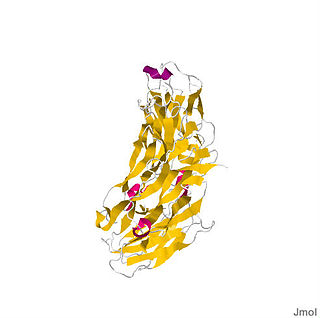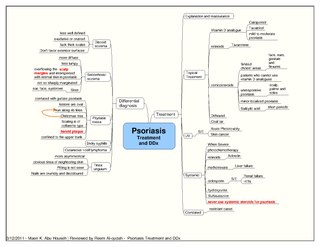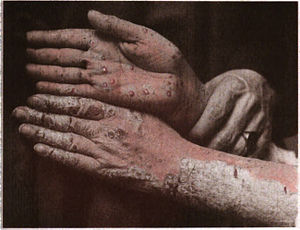
Psoriasis is a long-lasting, noncontagious autoimmune disease characterized by raised areas of abnormal skin. These areas are typically red, or purple on some people with darker skin, dry, itchy, and scaly. Psoriasis varies in severity from small, localized patches to complete body coverage. Injury to the skin can trigger psoriatic skin changes at that spot, which is known as the Koebner phenomenon.

Psoriatic arthritis is a long-term inflammatory arthritis that occurs in people affected by the autoimmune disease psoriasis. The classic feature of psoriatic arthritis is swelling of entire fingers and toes with a sausage-like appearance. This often happens in association with changes to the nails such as small depressions in the nail (pitting), thickening of the nails, and detachment of the nail from the nailbed. Skin changes consistent with psoriasis frequently occur before the onset of psoriatic arthritis but psoriatic arthritis can precede the rash in 15% of affected individuals. It is classified as a type of seronegative spondyloarthropathy.

The retinoids are a class of chemical compounds that are vitamers of vitamin A or are chemically related to it. Retinoids have found use in medicine where they regulate epithelial cell growth.

Balneotherapy is a method of treating diseases by bathing, a traditional medicine technique usually practiced at spas. While it is considered distinct from hydrotherapy, there are some overlaps in practice and in underlying principles. Balneotherapy may involve hot or cold water, massage through moving water, relaxation, or stimulation. Many mineral waters at spas are rich in particular minerals such as silica, sulfur, selenium, and radium. Medicinal clays are also widely used, a practice known as 'fangotherapy'.

Calcipotriol, also known as calcipotriene, is a synthetic derivative of calcitriol, a form of vitamin D. It is used in the treatment of psoriasis. It is safe for long-term application in psoriatic skin conditions.

Interleukin 17 family is a family of pro-inflammatory cystine knot cytokines. They are produced by a group of T helper cell known as T helper 17 cell in response to their stimulation with IL-23. Originally, Th17 was identified in 1993 by Rouvier et al. who isolated IL17A transcript from a rodent T-cell hybridoma. The protein encoded by IL17A is a founding member of IL-17 family. IL17A protein exhibits a high homology with a viral IL-17-like protein encoded in the genome of T-lymphotropic rhadinovirus Herpesvirus saimiri. In rodents, IL-17A is often referred to as CTLA8.

Interleukin 19 (IL19) is a protein that in humans is encoded by the IL19 gene on the chromosome 1.

Interleukin-17 receptor (IL-17R) is a cytokine receptor which belongs to new subfamily of receptors binding proinflammatory cytokine interleukin 17A, a member of IL-17 family ligands produced by T helper 17 cells (Th17). IL-17R family consists of 5 members: IL-17RA, IL-17RB, IL-17RC, IL-17RD and IL-17RE. Functional IL-17R is a transmembrane receptor complex usually consisting of one IL-17RA, which is a founding member of the family, and second other family subunit, thus forming heteromeric receptor binding different ligands. IL-17A, a founding member of IL-17 ligand family binds to heteromeric IL-17RA/RC receptor complex. IL-17RB binds preferentially IL-17B and IL-17E and heteromeric IL-17RA/RE complex binds IL-17C. However, there is still unknown ligand for IL-17RD. The first identified member IL-17RA is located on human chromosome 22, whereas other subunits IL-17RB to IL-17RD are encoded within human chromosome 3.

Splinter hemorrhages are tiny blood clots that tend to run vertically under the nails. Splinter hemorrhages are not specific to any particular condition, and can be associated with subacute infective endocarditis, scleroderma, trichinosis, systemic lupus erythematosus (SLE), rheumatoid arthritis, psoriatic nails, antiphospholipid syndrome, haematological malignancy, and trauma. At first they are usually plum-colored, but then darken to brown or black in a couple of days. In certain conditions, clots can migrate from the affected heart valve and find their way into various parts of the body. If this happens in the finger, it can cause damage to the capillaries resulting in a splinter hemorrhage.

Psoriatic erythroderma represents a form of psoriasis that affects all body sites, including the face, hands, feet, nails, trunk, and extremities. This specific form of psoriasis affects 3 percent of persons diagnosed with psoriasis. First-line treatments for psoriatic erythroderma include immunosuppressive medications such as methotrexate, acitretin, or ciclosporin.
Annular pustular psoriasis is a rare variant of pustular psoriasis, having an annular, or circinate, lesion morphology that may appear at the onset of pustular psoriasis, with a tendency to spread and form enlarged rings.

Inflammatory Linear Verrucous Epidermal Nevus is a rare disease of the skin that presents as multiple, discrete, red papules that tend to coalesce into linear plaques that follow the Lines of Blaschko. The plaques can be slightly warty (psoriaform) or scaly (eczema-like). ILVEN is caused by somatic mutations that result in genetic mosaicism. There is no cure, but different medical treatments can alleviate the symptoms.

Acroosteolysis is resorption of the distal bony phalanges. Acroosteolysis has two patterns of resorption in adults: diffuse and bandlike.
Ixekizumab, sold under the brand name Taltz, is an injectable medication for the treatment of autoimmune diseases. Chemically, it is a form of a humanized monoclonal antibody. The substance acts by binding interleukin 17A and neutralizing it, reducing inflammation.
Secukinumab, sold under the brand name Cosentyx, is a human IgG1κ monoclonal antibody that binds to the protein interleukin (IL)-17A, and is marketed by Novartis for the treatment of psoriasis, ankylosing spondylitis, and psoriatic arthritis. It inhibits a member of the cytokine family, interleukin 17A.
Tildrakizumab is a monoclonal antibody designed for the treatment of immunologically mediated inflammatory disorders. It is approved for the treatment of adult patients with moderate-to-severe plaque psoriasis in the United States and the European Union.
Guselkumab, sold under the trade name Tremfya, is a monoclonal antibody against interleukin-23 used for the treatment of plaque psoriasis.

Interleukin-23 (IL-23) is a heterodimeric cytokine composed of an IL12B (IL-12p40) subunit and the IL23A (IL-23p19) subunit. IL-23 is part of IL-12 family of cytokines. A functional receptor for IL-23 has been identified and is composed of IL-12R β1 and IL-23R. Adnectin-2 is binding to IL-23 and compete with IL-23/IL-23R. mRNA of IL-23R is 2,8 kB in length and includes 12 exons. The translated protein contains 629 amino acids, which is a type I penetrating protein includes signal peptide, an N-terminal fibronectin III-like domain and an intracellular part contains 3 potential tyrosine phosphorylation domains. There are 24 variants of splicing of IL-23R in mitogen-activated lymphocytes. IL-23R has some single nucleotide polymorphisms in the domain of binding IL-23 so there can be differences in activation of Th17. There is also variant of IL-23R which has just extracellular part and it´s known as soluble IL-23R. This form can compete with membrane form to bind IL-23 and there can be difference in activation of Th17 immune response and regulation of inflammation and immune function.

Calcipotriol/betamethasone dipropionate, sold under the brand name Taclonex among others, is a fixed-dose combination medication of the synthetic vitamin D3 analog calcipotriol (also known as calcipotriene) and the synthetic corticosteroid betamethasone dipropionate for the treatment of plaque psoriasis. It is used in the form of ointment, topical suspension, gel, aerosol, and foam.
Risankizumab, sold under the brand name Skyrizi, is a humanized monoclonal antibody targeting interleukin 23A (IL-23A). Risankizumab is part of a collaboration between Boehringer Ingelheim and AbbVie. Risankizumab has been approved in the European Union, the United States, Canada, and Japan for treatment of moderate to severe plaque psoriasis in adults who are candidates for systemic therapy.













